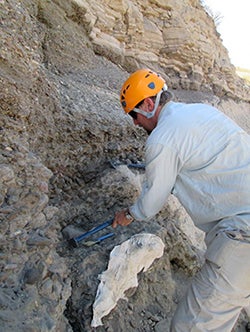 Two sabertooth salmon skulls gingerly removed from a quarry near Madras have put a big bite in what is known about the large ancient fish species: Their teeth don't go up and down.
Two sabertooth salmon skulls gingerly removed from a quarry near Madras have put a big bite in what is known about the large ancient fish species: Their teeth don't go up and down.
“Over the last 50 years, incomplete sabertooth salmon skulls have been reconstructed so that the teeth point downward from the upper jaw, much as you’d see in a sabertooth cat,” said Edward B. Davis, a paleontologist with the UO Museum of Natural and Cultural History. "In these newly uncovered fossils, which are the first to be found with the saberteeth intact in the skulls, the teeth are actually pointing sideways out of the jaw.”
The fossil evidence suggests that the sideways positioning isn’t an anomaly. “This isn’t one unusual individual; we have two skulls presenting the same pattern,” Davis said.
The sabertooth salmon, known as Oncorhynchus rastrosus to paleontologists, was exceptionally large, measuring between 6 and 8 feet long. The species was present in Oregon waters until about five million years ago.
The newly uncovered skulls are now at the UO being prepared for further study. Davis is collaborating with several other scientists to write a paper that describes the discovery and explores its implications.
The museum's paleontological collections include a number of other sabertooth salmon fossils collected from the Madras-area quarry. A skull specimen unearthed there in 1964 has served as the scientific community’s reference point for defining and naming the species.
A touchable cast of that 1964 find is currently on display in the museum’s "Explore Oregon" exhibit, which opened earlier this year. The display also includes a life-size mural of the fish, painted by the Alaska artist Ray Troll, who once called the museum “a shrine to the mighty sabertooth salmon.”
—By Kristin Strommer, Museum of Natural and Cultural History


